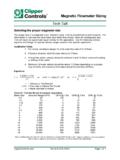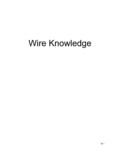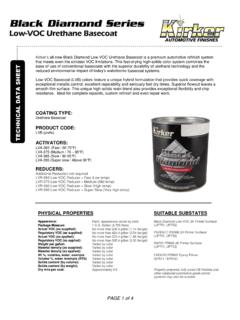Transcription of Why Use Temperature Transmitters Instead of …
1 PROCESST emperatureSensor(RTD orThermocouple)"Weak" Low-Level Signal(ohm or mV) Readout andControl SystemSensor Lead andExtension WireTerminationsPROCESST emperatureSensor(RTD orThermocouple)"Strong" High-Level Signal(4-20mA) Readout andControl SystemTemperature transmitter +PS-PS1234 TDYT ransmitters vs. Direct WiringWhen making Temperature measurements, two wayshave traditionally been employed to get processreadings back to a monitoring and control method is to utilize sensor extension wiresto carry the low-level signals (ohm or mV) generatedby field-mounted RTD or thermocouple sensors(Figure 1). Another is to install Temperature trans-mitters at or near the measurement point.
2 Thetransmitter amplifies and conditions the sensorsignal, and transmits it over a twisted wire pair backto the control room (Figure 2).Direct wiring strategies have generally been consid-ered less expensive and sometimes easier. Transmitteruse, because of cost considerations, was often reservedfor important loops and applications where signal andloop integrity was a , our highly functional, yet very affordable,microprocessor-based field-mount Temperature transmit-ters are comparable in price to direct wiring the additional advantages of using intelligenttransmitters are factored in you will, in most applications,also save considerable time and maintenance head-aches. This is especially true when the measurementpoint is located a long distance from the readout andcontrol UseTemperature TransmittersInstead of Direct Wiring?
3 Figure 2. A Temperature transmitter amplifies and conditions theprimary sensor signal, then carries it over a twisted pair wire to thecontrol 1. Sensor extension wires carry low-level (ohm or mV)signals generated by a field-mounted RTD or are just some of the reasons why you shoulduse Moore Industries intelligent temperaturetransmitters in place of direct wiring strategies:Cut Wiring CostsDirect wiring sensors to a control system requires the useof sensor extension wires. Not only are extension wiresfragile, they also cost three times more than the commonshielded copper wire used for a Temperature transmitter s4-20mA signal. Using the less expensive wires, transmit-ters can pay for themselves in wire and conduit costsalone.
4 The longer the wire run, the greater the retrofit situations, you may wish to switch to trans-mitters, but are reluctant to do so because some mistak-enly believe that new copper wires must be run to accom-modate the 4-20mA. This is not the case. Temperaturetransmitters can be installed at the sensor, and the in-place RTD or thermocouple extension wires can be usedto transmit the 4-20mA back to the control system. Thismeans no additional installation time or material costs(including conduit) will be needed. And you still get all ofthe advantages of using Temperature Signals from Plant NoiseCommon in nearly every industrial environment, RFI(radio frequency interference) and EMI (electromagneticinterference) can negatively affect process you eliminate RFI and EMI as a possible culprit oferratic signals, consider just some of the commonsources: Mobile and stationary radio, television, andhand-held walkie-talkies; radio-controlled overhead cranes;radar; induction heating systems; static discharge; highspeed power switching elements; high ac current conduc-tors; large solenoids and relays; transformers; ac and dcmotors; welders.
5 And even fluorescent you have one or more of these in your plant, youmay have a RFI/EMI problem. The result is sometimesjust a minor inconvenience. Other times it can be asThe Interface Solution Experts 1 Intelligent, Universal Temperature TransmitterProgramming istypicallyaccomplishedusing a PC, hand-held configurator, or on-board controlsHandles All Common Sensor TypesThermocouple (J, K, E, T, R, S, B, N, and C) and RTD (Pt, Cu, and Ni) Scaleable, Isolated4-20mA SignalReady for directinterface with DCS,PLC, SCADA, and similar readoutdevices andsystemsserious as a costly plant a direct wiring scheme, the low-level signalsgenerated by an RTD (ohm) or thermocouple (mV) areparticularly susceptible to the signal degrading effects ofRFI/EMI.
6 Compounding theproblem, sensor extensionwires can behave muchlike an RFI/EMI antennaby actually drawingplant noise to thewires, and affectingweak, low-levelsignals. Con-versely, a properlydesigned tempera-ture transmittereffectively negates theeffects of incoming RFInoise by converting a sensor slow-level signal to a high-levelanalog signal (typically 4-20mA).This amplified signal is resistantto RFI/EMI, and can accuratelywithstand long distance transmis-sion from the field, through anoisy plant, back to the controlroom. When specifying yourtransmitter, always check forRFI/EMI protection. If there s nospecification given, it s usuallybecause the instrument is notdesigned to resist noise.
7 It willprobably not perform very well ina noisy plant Ground LoopsMake sure to choose an isolated transmitter (even today,not all are!). Our transmitter s input/output/power signalisolation protects against signal inaccuracies caused byground loops. This is important even when using un-grounded thermocouples because their insulation willeventually break Hardware and Stocking CostsWith direct wiring, it is necessary to match the sensortype to input-specific DCS and PLC input cards. Sensorinput-specific cards usually cost a lot more per point thana 4-20mA input card. And since numerous sensor typesare routinely used in a plant, a large number of differentcards must be ordered and kept on hand as spares.
8 Thisis not only expensive, but can result in a lot of confusionwhen installing, maintaining, and replacing Temperature Transmitters incorporate powerfulmicroprocessors that allow them to be easily configuredto accommodate nearly any sensor input type. Their4-20mA output signal is control-system ready. Thisallows you to standardize on (and stock) less expensive4-20mA DCS and PLC input the Best Sensor to the ApplicationIn an intelligent Temperature transmitter strategy, yousimply change out the sensor and reconfigure thetransmitter to accommodate the different sensor loop s twisted pair wiring and existing 4-20mA inputboards don t even have to be touched. Because younever know what sensor you ll end up with, make sure togo with a universal transmitter that configures to acceptall common Temperature sensor types and temperatureranges (Figure 3).
9 Enhance Accuracy and StabilityUsing Temperature Transmitters can substantially en-hance measurement accuracy. DCS and PLC systemsmeasure readings over the entire (very wide) range of asensor. It is well known that measuring a narrower rangeproduces far more accurate measurements. Transmitterscan be calibrated to any range within a sensor s overallcapabilities. Their measurements are moreThe Interface Solution Experts 2 Figure 3. Our universal Temperature Transmitters configure to handlenearly every Temperature sensor type and Temperature UseTemperature TransmittersInstead of Direct Wiring?Why UseTemperature TransmittersInstead of Direct Wiring?The Interface Solution Experts 3 Figure 4.
10 Sensor-to- transmitter Trimming compensates for deviationsin a Temperature sensor s established than is possible with most direct wiring Transmitters deliver accuracy ratings of C( F) when paired with a common Pt100 RTDsensor over a 200 you need even better accuracy, you can trim ouruniversal Transmitters to precisely match a particularsensor. Even though sensors are designed to have ahigh degree of conformance to an established curve,each one (even precision sensors) will vary slightly fromtheir stated specification. In the past, transmittersassumed an accurate sensor measurement and pro-cessed it accordingly. Our Transmitters can be trimmedto match the measurement actually being taken by eachindividual Sensor-to- transmitter Trimming, the transmit-ter is connected to the sensor and then immersed incalibration baths maintained at stabilized temperatures (Figure 4).










